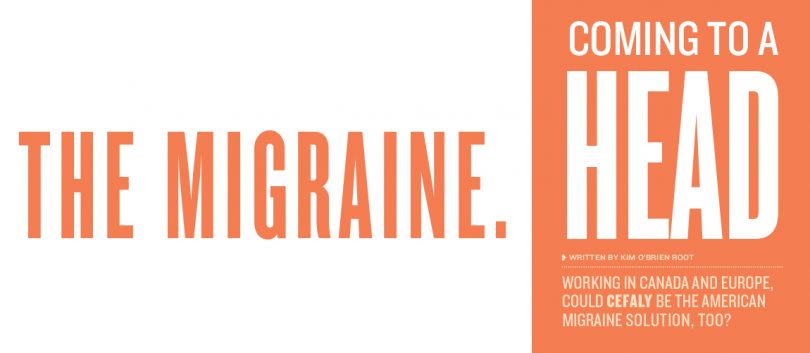Working in Canada and Europe, could Cefaly be the American migraine solution, too?
The Migraine.
The throbbing, pulsing kind of headache that can send you crawling under the bedcovers in unbelievable pain.
Sometimes medication works; sometimes it doesn’t. Certain foods are thought to bring on migraines, so sufferers are advised to avoid them—things such as chocolate, caffeine, cheese and the additive MSG. Not drinking enough water or getting enough sleep can trigger migraines, too.
Now, there’s something that’s not a medication or lifestyle change that could help.
It’s a device called Cefaly—a battery powered headband that’s worn across the forehead to stimulate the nerves associated with migraines. Manufactured in Belgium, the device has been used in Europe and Canada for some time, but only recently was approved for marketing in the United States by the U.S. Food and Drug Administration.
Cefaly may help patients who can’t tolerate medications for preventing or treating migraines, says Christy Foreman, director of the Office of Device Evaluation at the FDA’s Center for Devices and Radiological Health.
Migraines aren’t regular headaches. They’re characterized by intense throbbing in one area of the head, usually accompanied by nausea or vomiting and sensitivity to light and sound. Their causes aren’t well understood, although doctors believe migraines might be caused by the way the brain interacts with the trigeminal nerve, a major pain pathway.
“The brain is very complex,” says Dr. Rajinder Singh, a neurologist with Peninsula Neurology in Newport News, Va. “Migraines are a complex syndrome. Everybody doesn’t get the same symptoms.”
Imbalances in brain chemicals including serotonin, which helps regulate pain in the nervous system, may also play a part. Migraines are often hereditary, and are three times more common in women than in men, leading doctors to believe hormones also are involved. Some 10 percent of people worldwide get migraines, according to the National Institutes of Health.
The FDA reviewed the safety and effectiveness of Cefaly based on studies in Belgium and in France. One study showed that those who used the device experienced significantly fewer days with migraines per month, and also needed less medication to treat an onset of a migraine.
“The results weren’t robust, but [Cefaly is] something that’s well-tolerated,” says Dr. Amelito Malapira, a neurologist with Sentara Neurology Specialists in Virginia Beach, Va. “So it’s a welcome addition to what we have now, which is mostly medications.”
Malapira has yet to get his hands on one of the devices, but he says he’s eager to get one and evaluate its effectiveness for himself. He says he’s encouraged by what he’s read and heard.
The accepted treatments for migraines in the U.S. are medications, lifestyle changes and Botox. Botox, which can be injected around the forehead, is thought to interfere with the release of a pain-producing chemical, therefore reducing the signals that go back to the brain. The theory is that if you lessen the signals, you lessen the migraines.
Both Malapira and Singh use Botox as a migraine treatment in their offices. Patients have to try medication before insurance will approve the use of Botox, Singh says, since it usually requires three treatments spaced three months apart.
Just the process of finding the right medication can be a tricky one, says Malapira. One kind might be effective for one person, but not for another.
Treating migraines “is an art and science at the same time,” Malapira says. “You want to use something that’s effective and tolerable. Therein lies some of the challenge.”
Malapira says Cefaly is unlikely to be covered by insurance in the U.S. at this time. The device, which uses replaceable electrodes, is available by prescription on the company’s website, www.cefaly.us, for $295. Time will tell how available it becomes. In Canada, you can buy it at Costco.
Update: Since this writing, the FDA approved Cefaly. Learn more here.



